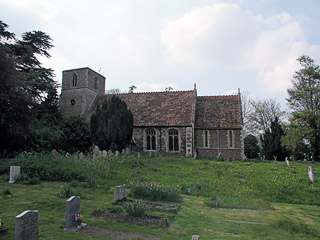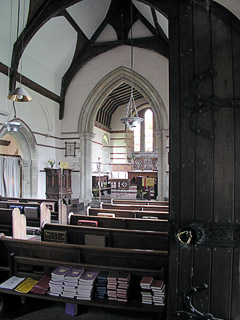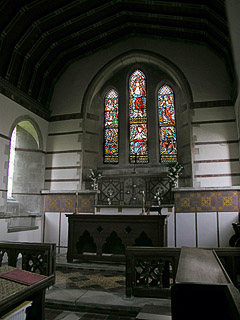We made a mistake at Tadlow.
St Giles isn't very easy to find - at first we went down into the village, only to discover that the church was back up on the main road, set back a little way into woodland. We returned, but the only track leading north appeared to be the drive of Tadlow House. In itself, this isn't unusual - we'd come across churches in the grounds of big houses before, for example at Landwade. We swept round the drive and got a lovely view of the house, with the church rising behind it. However there was no obvious way to get there - the drive just went to the front door, and there seemed to be no gate next to the house. There was, however, a twin set of ruts in the lawn to our left, leading to a little wood at the back of the garden. Somewhat at a loss, we tried that, only to find ourselves in a field with no way out.
At this point, we felt a bit foolish, and decided to retreat and check the map once again. By this time we had been noticed however... by the lady of the house, who was running up the rutted track to confront us. 'I'm terribly sorry, we were looking for the way to the church, but we seem to have become rather lost' said Mark. It's one of the few times I've ever heard him sound abashed: he normally remains bluff and hearty long after I have turned scarlet and been reduced to stuttering apologies. [Mark adds: I usually become extremely well-spoken and polite in circumstances like this - my voice adapts to whatever social class I deem suitable for the person who I've offended and I take on a certain vague, bumbling air to make myself seem as unthreatening as possible - an approach that didn't work especially well with the Chatelaine of Tadlow]
She fixed us with a terrifying gaze and, in a icy and clipped voice, said 'Yes, you are lost'. I turned pale - this was serious. Normally, people with accents like that say something like 'No no, really, I quite understand; please, don't feel at all worried' and make it sound like a reprimand. If they're really cross they might invite you in for tea, as happened to my old headteacher when he accidentally wandered into the private garden of Duntrune Castle in Argyll. The cold terse agreement we received therefore had much the same effect on me as a grade one thermonuclear dressing-down, in front of the whole school, with venerable relatives in the back row weeping with disappointment and altering their wills. Not that I can blame her, of course - after all, we had just driven a motorbike across her lawn. She probably thought we were casing the joint with a view to stealing heirlooms or poisoning her corgis. Anyway, after we had made a few more profuse apologies, she gave us directions and we set off.
All ye who follow in our footsteps can avoid our pain by stopping at the brick bus shelter on the main road, and following a little path up into the woods. It's not as grand as the drive of Tadlow House, but it'll save you the embarassment.
Just after we arrived in the church and I was starting to make my notes, the lord of the manor appeared. He was extremely affable, asking us if there was anything he could do to help, and pointing out a few details with his extremely expensive cigar. I wondered what had just passed between him and his wife - 'Charles, there were two men on a scooter driving over our lawn! They said they were trying to find the church, but I bet they were after the diamonds. Go and see if they visit the church - if they don't, I've got the number plate and give their scent to the hounds.' [Mark adds: I think Ben's being a bit unfair to her, we had ridden across her garden after all. The husband was a delightful old cove. Thinking back I wish I'd told him how impressed I was by his wife's turn of speed as she ran after us - and the fact that she wasn't even out of breath afterwards] Anyway, we evidently persuaded him of our benign intentions, for he left quite quickly.
Still cringing, we examined the church. Sadly, after all that excitement, there isn't much to say about it. It is a simple aisleless structure, with a 13th century nave and a 14th century tower that is slightly out of alignment. The chancel was evidently shortened at some point, for the east wall dates from around 1748.
The interior has been very heavily restored by William Butterfield, who was employed to give the place a makeover in 1860. Evidently tiles were in fashion that year - having scrubbed the nave walls to pristine whiteness and reconstructed the inside of the chancel, he put strange horizontal bands of red tiles around the nave walls at eye-level. His reredos is particularly horrid - unimaginative patterns of muddy-coloured tiles. Most of the glass dates from this time, and most of it is bad. The easternmost window of the south nave wall is better - simple floral designs rather than lurid saints - but the glass is bowing inwards so badly that I doubt it will last long.
Once upon a time, there was something rather nice in the church. In the tower is a drawing of an incised slab which lies just inside the south door. It once showed a very grand woman in praying posture and late medieval garb, surrounded by coats of arms and with her six children at her feet. This was the memorial for one Margaret Brogriffe, who died in 1493, it has now worn away to near-invisibility. We slunk away, and vowed never to return.
St Giles is kept open


